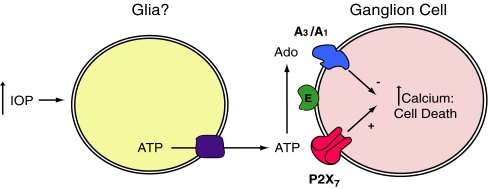Fig. 2.
Schematic model describing the hypothesized relationship between elevated intraocular pressure (IOP), excess extracellular ATP, P2X7 and adenosine receptors, and ganglion cell death. The increased levels of calcium inside ganglion cells following stimulation of the P2X7 receptor may lead to cell death but may also damage cell signaling under chronic conditions. The dephosphorylation of ATP by ectonucleotidases (E) produces adenosine that is neuroprotective by acting at A3 (and possibly A1) receptors to limit the rise in calcium and cell death. The converse relationship between the harmful effects of excess ATP and the beneficial actions of adenosine suggests the health of retinal ganglion cells is influenced by the balance of purines in extracellular space. The depiction of glial cells as the source of pressure-dependent ATP is based on the findings of Newman [37, 38], although it remains to be determined whether alternative sources contribute to extracellular ATP levels under sustained periods of elevated pressure. The identity of the conduit for ATP exit is presently unknown

